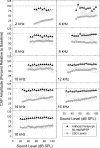Disruption of lateral olivocochlear neurons via a dopaminergic neurotoxin depresses sound-evoked auditory nerve activity
- PMID: 15735934
- PMCID: PMC2504639
- DOI: 10.1007/s10162-004-5009-2
Disruption of lateral olivocochlear neurons via a dopaminergic neurotoxin depresses sound-evoked auditory nerve activity
Abstract
We applied the dopaminergic (DA) neurotoxin 1-methyl-4-phenyl-1,2,3,6-tetrahydropyridine (MPTP) to the guinea pig cochlear perilymph. Immunolabeling of lateral olivocochlear (LOC) neurons using antibodies against synaptophysin was reduced after the MPTP treatment. In contrast, labeling of the medial olivocochlear innervation remained intact. As after brainstem lesions of the lateral superior olive (LSO), the site of origin of the LOC neurons, the main effect of disrupting LOC innervation of the cochlea via MPTP was a depression of the amplitude of the compound action potential (CAP). CAP amplitude depression was similar to that produced by LSO lesions. Latency of the N1 component of the CAP, and distortion product otoacoustic emission amplitude and adaptation were unchanged by the MPTP treatment. This technique for selectively lesioning descending LOC efferents provides a new opportunity for examining LOC modulation of afferent activity and behavioral measures of perception.
Figures








Similar articles
-
Disruption of lateral olivocochlear neurons with a dopaminergic neurotoxin depresses spontaneous auditory nerve activity.Neurosci Lett. 2014 Oct 17;582:54-8. doi: 10.1016/j.neulet.2014.08.040. Epub 2014 Aug 29. Neurosci Lett. 2014. PMID: 25175420 Free PMC article.
-
Disruption of lateral efferent pathways: functional changes in auditory evoked responses.J Assoc Res Otolaryngol. 2003 Jun;4(2):276-90. doi: 10.1007/s10162-002-3018-6. J Assoc Res Otolaryngol. 2003. PMID: 12943378 Free PMC article.
-
Noradrenergic modulation of brainstem nuclei alters cochlear neural output.Hear Res. 2005 Jun;204(1-2):147-55. doi: 10.1016/j.heares.2005.01.009. Hear Res. 2005. PMID: 15925200
-
Morphofunctional alterations in the olivocochlear efferent system of the genetic audiogenic seizure-prone hamster GASH:Sal.Epilepsy Behav. 2017 Jun;71(Pt B):193-206. doi: 10.1016/j.yebeh.2016.05.040. Epub 2016 Aug 1. Epilepsy Behav. 2017. PMID: 27492627 Review.
-
Olivocochlear efferents: Their action, effects, measurement and uses, and the impact of the new conception of cochlear mechanical responses.Hear Res. 2018 May;362:38-47. doi: 10.1016/j.heares.2017.12.012. Epub 2017 Dec 21. Hear Res. 2018. PMID: 29291948 Free PMC article. Review.
Cited by
-
Brainstem auditory evoked potentials suggest a role for the ventral cochlear nucleus in tinnitus.J Assoc Res Otolaryngol. 2012 Dec;13(6):819-33. doi: 10.1007/s10162-012-0344-1. Epub 2012 Aug 7. J Assoc Res Otolaryngol. 2012. PMID: 22869301 Free PMC article.
-
Sound exposure dynamically induces dopamine synthesis in cholinergic LOC efferents for feedback to auditory nerve fibers.Elife. 2020 Jan 24;9:e52419. doi: 10.7554/eLife.52419. Elife. 2020. PMID: 31975688 Free PMC article.
-
Dopamine Modulates the Activity of Sensory Hair Cells.J Neurosci. 2015 Dec 16;35(50):16494-503. doi: 10.1523/JNEUROSCI.1691-15.2015. J Neurosci. 2015. PMID: 26674873 Free PMC article.
-
Selective removal of lateral olivocochlear efferents increases vulnerability to acute acoustic injury.J Neurophysiol. 2007 Feb;97(2):1775-85. doi: 10.1152/jn.00955.2006. Epub 2006 Nov 8. J Neurophysiol. 2007. PMID: 17093118 Free PMC article.
-
Efferent synapses return to inner hair cells in the aging cochlea.Neurobiol Aging. 2012 Dec;33(12):2892-902. doi: 10.1016/j.neurobiolaging.2012.02.007. Epub 2012 Mar 8. Neurobiol Aging. 2012. PMID: 22405044 Free PMC article.
References
-
- Abou-Madi L, Pontarotti P, Tramu G, Cupo A, Eybalin M. Coexistence of putative neuroactive substances in lateral olivocochlear neurons of rat and guinea pig. Hear. Res. 1987;30:135–146. - PubMed
-
- Adams JC, Mroz EA, Sewell WF. A possible neurotransmitter role for CGRP in a hair-cell sensory organ. Brain Res. 1987;419:347–351. - PubMed
-
- Altschuler RA, Parakkal MH, Fex J. Localization of enkephalin-like immunoreactivity in acetylcholinesterase-positive cells in the guinea-pig lateral superior olivary complex that project to the cochlea. Neuroscience. 1983;9:621–630. - PubMed
-
- Altschuler RA, Fex J, Parakkal MH, Eckenstein F. Colocalization of enkephalin-like and choline acetyltransferase-like immunoreactivities in olivocochlear neurons of the guinea pig. J. Histochem. Cytochem. 1984;32:839–843. - PubMed
-
- Altschuler RA, Hoffman DW, Reeks KA, Fex J. Localization of dynorphin B-like and alpha-neoendorphin-like immunoreactivities in the guinea pig organ of Corti. Hear. Res. 1985;17:249–258. - PubMed
Publication types
MeSH terms
Substances
Grants and funding
LinkOut - more resources
Full Text Sources
Research Materials
Miscellaneous

